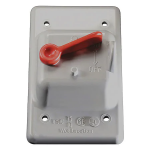mbrooke
Batteries Included
- Location
- United States
- Occupation
- Technician
Don't tell anyone, I still don't bond them when in a PVC box with PVC cover (external operator type covers)
I think they decided cover screws are typically metallic and could still become energized if the yoke became energized. Personally still think isn't that big of an issue in a dwelling when there aren't any grounded surfaces in the vicinity, but I also don't think you can come up with any explanation that a CMP would ever accept to revert this rule.
You and me are going to have issues from now on
Seriously, the EGC is your friend.


